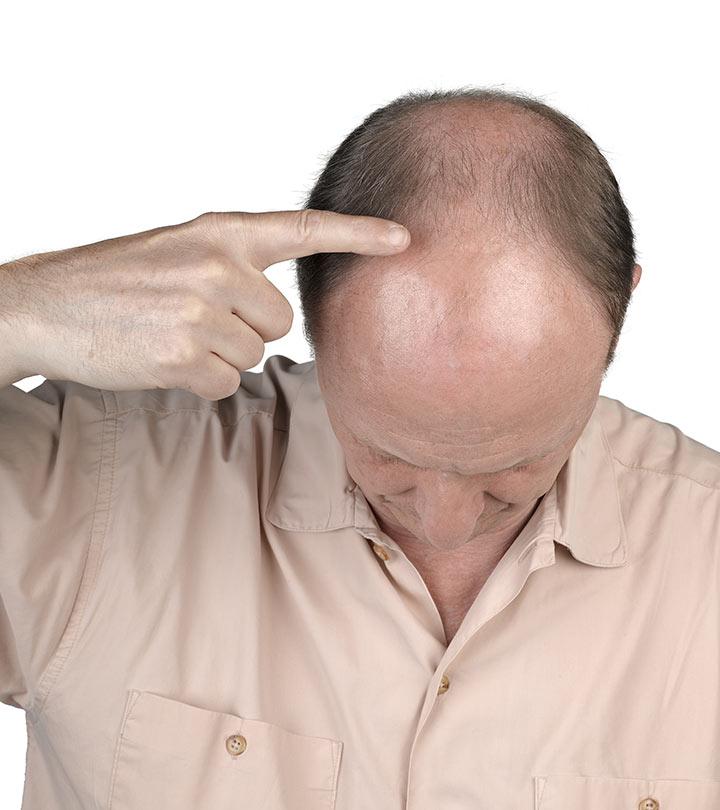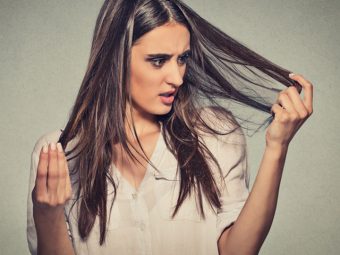Frontal Hair Loss: Causes And How To Treat It
Restore your healthy lifestyle and work on stress reduction to regain your hair.

The most prevalent type of hair loss in men in their 30s is frontal hair loss or a receding hairline. Frontal balding, popularly called the frontal fibrosing alopecia (FFA) or widow’s peak, is related to the prevalent hair loss condition. This dreadful type of hair loss has a detrimental impact on a person’s look, creating discomfort and lowering their self-confidence. In addition, it is the earliest sign of hair thinning and the first level of male pattern baldness (1).
Hair loss from the scalp surrounding the forehead and the brows and armpits is a common symptom of FFA. This condition is thought to be caused by hormonal fluctuations or an autoimmune reaction in the body (2). On the other hand, this unfavorable condition can be addressed and slowed using clinical, therapeutic, and medical procedures and treatments. Maintaining a proper lifestyle and eating a balanced diet is necessary to battle hair loss.
Causes
General hair loss is caused by various factors. Unhealthy diet and lifestyle, physiological and psychological stress, improper hair care etiquette, hormonal change, scalp infection, illness and medications etc cause hair fall.
However, hormonal changes in the body and scalp and genetic factors are known to be the prime cause for male pattern baldness. The male hormone called dihydrotestosterone or DHT is an androgen that is majorly responsible for frontal balding (1). DHT is responsible for development of manly attributes in males. A very small percentage of DHT is also found in women. Increased level of this hormone in women also causes development of androgynous male secondary sex characteristics, like facial hair, while also prompting sudden hair fall (3).
DHT gets attached to the androgen receptors present in the dermal papilla of the hair follicles and inhibits the proper hair growth. This androgen prevents efficient absorption of growth nutrients from the blood by the papilla. This consequently restricts the optimal nourishment of the hair and stops the growth of the hair shaft. Increased level of DHT hormone in the scalp is genetically programmed to cause miniaturizing or shrinkage of the hair follicles. This hampers the creation of new hair follicles thereby leading to reduced hair growth, thinning and loss of hair due to follicle degradation. Thus regulating the levels of DHT in the body and restricting the androgen reception by the hair follicles is essential in solving the problem of frontal balding.
Treatments
Maintaining an appropriate lifestyle, healthy diet and remaining stress free by practicing yoga and meditation can help to naturally tackle the general hair loss issue and FFA problem. Boosting the immune system and keeping illnesses at bay is prerequisite for healthy hair. Use of hot hair treatments, styling tools, chemicals and stressful and tight hairstyling should be avoided as these easily cause the frontal hair to fall easily. Dandruff and other scalp infections along with scalp dehydration leads to blockage of hair follicles by excess sebum and scalp build up. This leads to insufficient nourishment of the hair which causes weakening of the hair root and eventually loss of hair (4). Hence one should use anti dandruff shampoos and treatments, like nizoral and head & shoulders, to cleanse the scalp and keep it infection free.
Hormonal levels should be regulated and controlled in the body and frontal hair loss treated by use of medicinal drugs, treatments and surgeries like:
Scalp Surgery
Techniques like scalp flab, hair transplant, FUE treatment, hair growth and restructuring have been used to deal with the frontal hair loss issue. It is an expensive treatment and should only be resorted to on recommendation of a doctor in case of chronic FFA.
Minoxidil
This topical lotion or foam needs to be rubbed on the affected region of the scalp every day. This rub on treatment is best to stop and prevent hair loss and to further delay balding. It also promotes regrowth of hair. Favorable results are visible 4 months after the start of the treatment. This is an expensive treatment and hence should be resorted to only on the advice of a doctor or a medical practitioner (5).
Finasteride
This medicine works by inhibiting the conversion of testosterone into dihydrotestosterone of DHT. The decrease in the level of DHT thus positively affects the pores to expand back to their normal size and therefore strengthen the hair and prevent hair loss. Consuming 1 tablet of finasteride each day helps to stop hair loss and promote regrowth of hair. The effect of this medicine is observed 4 months after starting the medication process while it can take up to 2 year for full hair growth to occur (6).
Frontal hair loss, popularly known as widow’s peak, may be caused by stress, poor lifestyle choices, genetics, or hormonal imbalances. Studies suggest that dihydrotestosterone is the hormone primarily responsible for frontal balding. You can go for medical treatments such as scalp surgery, medications, or topical ointments to treat hair loss. Furthermore, eating a healthy diet, doing yoga, and avoiding hot styling tools can help combat frontal hair loss and promote the growth of healthy hair. It is advisable to consult your doctor before going for any treatments.
Frequently Asked Questions
Can you regrow frontal hair?
As long as the hair follicles have not been damaged, you can regrow frontal hair.
Can frontal balding be reversed?
No. Currently, there are no solutions to reverse frontal balding.
Is finasteride better than minoxidil for the frontal hairline?
Both finasteride and minoxidil may help promote hair growth. They give the best results when used together. However, you should not self-medicate as improper use of these medicines may cause irritation and other adverse effects.
Sources
Articles on StyleCraze are backed by verified information from peer-reviewed and academic research papers, reputed organizations, research institutions, and medical associations to ensure accuracy and relevance. Read our editorial policy to learn more.
- Male pattern androgenetic alopecia
https://www.ncbi.nlm.nih.gov/labs/pmc/articles/PMC1113949/ - Frontal fibrosing alopecia An update on the hypothesis of pathogenesis and treatment
https://www.ncbi.nlm.nih.gov/labs/pmc/articles/PMC6451751/ - Androgen actions on the human hair follicle: perspectives
https://onlinelibrary.wiley.com/doi/full/10.1111/exd.12024 - Scalp Condition Impacts Hair Growth and Retention via Oxidative Stress
https://www.ncbi.nlm.nih.gov/labs/pmc/articles/PMC6369642/ - Minoxidil and its use in hair disorders a review
https://www.ncbi.nlm.nih.gov/labs/pmc/articles/PMC6691938/ - Finasteride-mediated hair regrowth and reversal of atrophy in a patient with frontal fibrosing alopecia
https://www.ncbi.nlm.nih.gov/labs/pmc/articles/PMC4809380/










